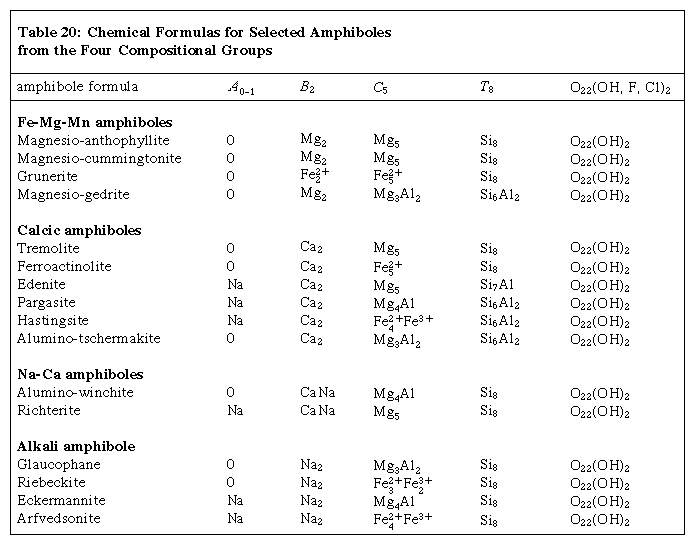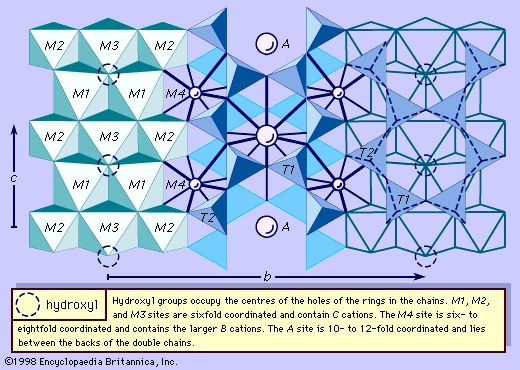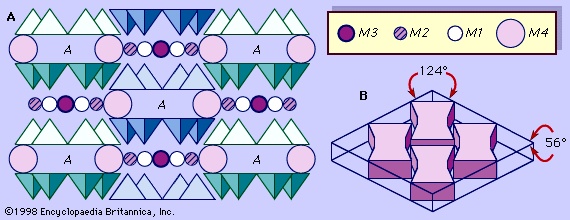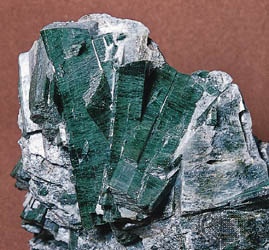amphibole
mineral
Introduction
any of a group of common rock-forming silicate minerals (silicate mineral).
General considerations
Amphiboles are found principally in metamorphic and igneous rocks. They occur in many metamorphic rocks (metamorphic rock), especially those derived from mafic igneous rocks (those containing dark-coloured ferromagnesian minerals) and siliceous dolomites. Amphiboles also are important constituents in a variety of plutonic and volcanic igneous rocks that range in composition from granitic to gabbroic. Amphibole, from the Greek amphibolos, meaning “ambiguous,” was named by the famous French crystallographer and mineralogist René-Just Haüy (Haüy, René-Just) (1801) in allusion to the great variety of composition and appearance shown by this mineral group. There are 5 major groups of amphibole leading to 76 chemically defined end-member amphibole compositions according to the British mineralogist Bernard E. Leake. Because of the wide range of chemical substitutions permissible in the crystal structure, amphiboles can crystallize in igneous and metamorphic rocks with a wide range of bulk chemistries. Typically amphiboles form as long prismatic crystals, radiating sprays, and asbestiform (fibrous) aggregates; however, without the aid of chemical analysis, it is difficult to megascopically identify all but a few of the more distinctive end-member amphiboles. The combination of prismatic form and two diamond-shaped directions of cleavage at about 56° and 124° is the diagnostic feature of most members of the amphibole group.
Chemical composition
 The complex chemical composition of members of the amphibole group can be expressed by the general formula A0–1B2C5T8O22(OH, F, Cl)2, where A = Na, K; B = Na, Zn, Li, Ca, Mn, Fe2+, Mg; C = Mg, Fe2+, Mn, Al, Fe3+, Ti, Zn, Cr; and T = Si, Al, Ti. Nearly complete substitution may take place between sodium and calcium and among magnesium, ferrous iron, and manganese (Mn). There is limited substitution between ferric iron and aluminum and between titanium and other C-type cations. Aluminum can partially substitute for silicon in the tetrahedral (T) site. Partial substitution of fluorine (F), chlorine, and oxygen for hydroxyl (OH) in the hydroxyl site is also common. The complexity of the amphibole formula has given rise to numerous mineral names within the amphibole group. In 1997 Leake presented a precise nomenclature of 76 names that encompass the chemical variation within this group. The mineral nomenclature of the amphiboles is divided into four principal subdivisions based on B-group cation occupancy: (1) the iron-magnesium-manganese amphibole group, (2) the calcic amphibole group, (3) the sodic-calcic amphibole group, and (4) the sodic amphibole group. The chemical formulas for selected amphiboles from each of the four compositional groups are given in the Table-->
The complex chemical composition of members of the amphibole group can be expressed by the general formula A0–1B2C5T8O22(OH, F, Cl)2, where A = Na, K; B = Na, Zn, Li, Ca, Mn, Fe2+, Mg; C = Mg, Fe2+, Mn, Al, Fe3+, Ti, Zn, Cr; and T = Si, Al, Ti. Nearly complete substitution may take place between sodium and calcium and among magnesium, ferrous iron, and manganese (Mn). There is limited substitution between ferric iron and aluminum and between titanium and other C-type cations. Aluminum can partially substitute for silicon in the tetrahedral (T) site. Partial substitution of fluorine (F), chlorine, and oxygen for hydroxyl (OH) in the hydroxyl site is also common. The complexity of the amphibole formula has given rise to numerous mineral names within the amphibole group. In 1997 Leake presented a precise nomenclature of 76 names that encompass the chemical variation within this group. The mineral nomenclature of the amphiboles is divided into four principal subdivisions based on B-group cation occupancy: (1) the iron-magnesium-manganese amphibole group, (2) the calcic amphibole group, (3) the sodic-calcic amphibole group, and (4) the sodic amphibole group. The chemical formulas for selected amphiboles from each of the four compositional groups are given in the Table--> .
.Numerous common amphiboles can be represented within the Mg7Si8O22(OH)2 (magnesio-anthophyllite)–Fe7Si8O22(OH)2 (grunerite)–“Ca7Si8O22(OH)2” (hypothetical pure calcium amphibole) compositional field (Figure 1). This diagram is commonly referred to as the amphibole quadrilateral. Complete substitution extends from tremolite 【Ca2Mg5Si8O22(OH)2】 to ferro-actinolite 【Ca2Fe5Si8O22(OH)2】. actinolite is the intermediate member of the tremolite-ferro-actinolite series. The compositional range from about 0.9 Mg7Si8O22(OH)2 to about Fe2Mg5Si8O22(OH)2 is represented by the orthorhombic amphibole known as anthophyllite. The monoclinic cummingtonite-grunerite series exists from about Fe2Mg2Si8O22(OH)2 to Fe7Si8O22(OH)2. Intermediate amphibole compositions do not exist between anthophyllite and the tremolite-actinolite series. Compositional gaps also exist between the cummingtonite-grunerite series and other calcic amphiboles. Consequently, coexisting pairs of anthophyllite-tremolite and grunerite-ferroactinolite are found together in some rocks. Sodium-bearing amphiboles are represented by the glaucophane 【Na2Mg3Al2Si8O22(OH)2】–riebeckite 【Na2Fe2+/3Fe3+/2Si8O22(OH)2】 series. Additional sodium is contained in the A site of the structure of arfvedsonite 【NaNa2Fe2+/4Fe3+Si8O22(OH)2】. For amphiboles that are not precisely characterized by their chemistry, it is not possible to assign a specific name. hornblende is the general name used for calcic amphiboles identified only by physical or optical properties.
The amphiboles differ chemically from the pyroxenes (pyroxene) in two major respects. Amphiboles have hydroxyl groups in their structure and are considered to be hydrous silicates that are stable only in hydrous environments where water can be incorporated into the structure as (OH)-. The second major compositional difference is the presence of the A site in amphiboles that contains the large alkali elements, typically sodium cations and at times potassium cations. The pyroxenes do not have an equivalent site that can accommodate potassium. The presence of hydroxyl groups in the structure of amphiboles decreases their thermal stability relative to the more refractory (heat-resistant) pyroxenes. Amphiboles decompose to anhydrous minerals (mainly pyroxenes) at elevated temperatures.
crystal structure




 The fundamental building block of all silicate mineral structures is the silicon-oxygen tetrahedron (SiO4)4-. It consists of a central silicon atom surrounded by four oxygen atoms in the shape of a tetrahedron. The essential characteristic of the amphibole structure is a double chain of corner-linked silicon-oxygen tetrahedrons that extend indefinitely parallel to the c crystallographic axis, the direction of elongation (Figure 2-->
The fundamental building block of all silicate mineral structures is the silicon-oxygen tetrahedron (SiO4)4-. It consists of a central silicon atom surrounded by four oxygen atoms in the shape of a tetrahedron. The essential characteristic of the amphibole structure is a double chain of corner-linked silicon-oxygen tetrahedrons that extend indefinitely parallel to the c crystallographic axis, the direction of elongation (Figure 2--> ). The tetrahedrons alternately share two and three oxygen atoms to produce a silicon-to-oxygen ratio of 4:11. The double chains repeat along their length at intervals of approximately 5.3 angstroms (Å), or 2.1 × 10-9 inch, and this defines the ideal c axis of the unit cell. The double chains are separated from other double chains and bonded to each other laterally by planes of cations and hydroxyl ions (Figure 3-->
). The tetrahedrons alternately share two and three oxygen atoms to produce a silicon-to-oxygen ratio of 4:11. The double chains repeat along their length at intervals of approximately 5.3 angstroms (Å), or 2.1 × 10-9 inch, and this defines the ideal c axis of the unit cell. The double chains are separated from other double chains and bonded to each other laterally by planes of cations and hydroxyl ions (Figure 3--> ). This figure illustrates the double chains as well as the octahedral strips to which they are bonded. The structure contains, besides the tetrahedral sites that constitute the chains, additional cation sites labeled A, M4, M3, M2, and M1. The A site contains the large alkali ions, mainly sodium, and is bonded to 10 to 12 oxygen and hydroxyl ions. The A site is filled to the extent necessary to maintain electrical neutrality, but typically the available A sites are not completely occupied. The M1, M2, and M3 octahedrons contain the C-type cations and share edges to form octahedral bands parallel to the c crystallographic direction. M1 and M3 bond to four oxygen atoms and two hydroxyl anions. M2 is coordinated by six oxygen atoms. M4 has sixfold to eightfold coordination and accommodates the B-type cations. The M4 site is most similar to the M2 site in pyroxene and accommodates Ca2+, as does the M2 site in pyroxene. Amphiboles have two each of the M1, M2, and M4 sites and one M3 site, giving a total of seven octahedral cations in the unit cell. The structure of a monoclinic amphibole viewed down the c crystallographic axis is shown in Figure 4A-->
). This figure illustrates the double chains as well as the octahedral strips to which they are bonded. The structure contains, besides the tetrahedral sites that constitute the chains, additional cation sites labeled A, M4, M3, M2, and M1. The A site contains the large alkali ions, mainly sodium, and is bonded to 10 to 12 oxygen and hydroxyl ions. The A site is filled to the extent necessary to maintain electrical neutrality, but typically the available A sites are not completely occupied. The M1, M2, and M3 octahedrons contain the C-type cations and share edges to form octahedral bands parallel to the c crystallographic direction. M1 and M3 bond to four oxygen atoms and two hydroxyl anions. M2 is coordinated by six oxygen atoms. M4 has sixfold to eightfold coordination and accommodates the B-type cations. The M4 site is most similar to the M2 site in pyroxene and accommodates Ca2+, as does the M2 site in pyroxene. Amphiboles have two each of the M1, M2, and M4 sites and one M3 site, giving a total of seven octahedral cations in the unit cell. The structure of a monoclinic amphibole viewed down the c crystallographic axis is shown in Figure 4A--> . The tetrahedral-octahedral-tetrahedral (t-o-t) strips, also known as I beams, are approximately twice as wide in the b direction as the equivalent t-o-t strips in pyroxenes because of the doubling of the chains in the amphiboles. The t-o-t I beams are schematically shown in Figure 4B-->
. The tetrahedral-octahedral-tetrahedral (t-o-t) strips, also known as I beams, are approximately twice as wide in the b direction as the equivalent t-o-t strips in pyroxenes because of the doubling of the chains in the amphiboles. The t-o-t I beams are schematically shown in Figure 4B--> . The structure ruptures around the stronger I beams, as shown in Figure 4B-->
. The structure ruptures around the stronger I beams, as shown in Figure 4B--> , producing the characteristic 56° and 124° amphibole cleavage angles.
, producing the characteristic 56° and 124° amphibole cleavage angles.The similarity between the crystal structures of the major layer silicates (phyllosilicate) (clays and micas) and the chain silicates (inosilicate) (pyroxenes and amphiboles) has long been recognized. The structures of all of these silicates can be considered as consisting of combinations of two structural units, the pyroxene I beams and the mica sheets. Both structures contain a band of octahedrons sandwiched between two oppositely pointing chains of tetrahedrons. Combinations of these two basic structural units, or “modules,” can produce all other minerals in the layer silicate and chain silicate groups. The term biopyribole has been used to describe any mineral that has both I beams and sheetlike structures. The name comes from biotite (mica), pyroxene, and amphibole. Biopyriboles have chain widths and repeat sequences like pyroxenes (single-chain repeats), amphiboles (double-chain repeats), and triple-chain repeats. The latter are intermediate between an amphibole I beam and the sheet structure of mica. Pyribole refers to any member of the biopyribole group, excluding the sheet silicates (i.e., the pyroxenes and amphiboles together).
Physical properties
Long prismatic, acicular, or fibrous crystal habit, Mohs hardness between 5 and 6, and two directions of cleavage intersecting at approximately 56° and 124° generally suffice to identify amphiboles in hand specimens. The specific gravity values of amphiboles range from about 2.9 to 3.6. Amphiboles yield water when heated in a closed tube and fuse with difficulty in a flame. Their colour ranges extensively from colourless to white, green, brown, black, blue, or lavender and is related to composition, principally the iron content. Magnesium-rich amphiboles such as anthophyllite, cummingtonite, and tremolite are colourless or light in colour. The tremolite-ferroactinolite series ranges from white to dark green with increasing iron content. The finely fibrous and massive variety of actinolite-tremolite known as nephrite jade ranges from green to black. Common hornblende is typically black. Glaucophane and riebeckite are usually blue. Anthophyllite is gray to various shades of green and brown. The cummingtonite-grunerite series occurs in various shades of light brown. Iron-free varieties of tremolite containing manganese can have a lavender colour.
 The common crystallographic habit of amphiboles is acicular or prismatic; however, most of the amphiboles are also known to crystallize in the asbestiform habit. The asbestiform variety of riebeckite is called crocidolite or blue asbestos. amosite is a rare asbestiform variety of grunerite, named from the company Amos (Asbestos Mines of South Africa). The most important commercial asbestos material is chrysotile, the asbestiform variety of serpentine.
The common crystallographic habit of amphiboles is acicular or prismatic; however, most of the amphiboles are also known to crystallize in the asbestiform habit. The asbestiform variety of riebeckite is called crocidolite or blue asbestos. amosite is a rare asbestiform variety of grunerite, named from the company Amos (Asbestos Mines of South Africa). The most important commercial asbestos material is chrysotile, the asbestiform variety of serpentine.In thin sections, amphiboles are distinguished by several properties, including two directions of cleavage at approximately 56° and 124°, six-sided basal cross sections, characteristic colour, and pleochroism (colour variance with the direction of light propagation). Orthorhombic amphiboles exhibit less intense pleochroism than the monoclinic amphiboles.
Origin and occurrence
Exhibiting an extensive range of possible cation substitutions, amphiboles crystallize in both igneous and metamorphic rocks with a broad range of bulk chemical compositions. Because of their relative instability to chemical weathering at the Earth's surface, amphiboles make up only a minor constituent in most sedimentary rocks.
Igneous rocks (igneous rock)
Calcic amphiboles are characteristically contained in igneous rocks. Igneous amphiboles are intermediate in composition between tremolite, tschermakite, edenite, and pargasite end-members. Typically, these amphiboles of intermediate composition are called hornblende. Hornblende occurs in various plutonic igneous rocks, including diorites, quartz diorites, and granodiorites. It also occurs as phenocrysts in andesite lavas that contained enough water for amphiboles to form. Hastingsite is found in granites and alkali-rich intrusives such as syenites. The alkali amphiboles riebeckite and arfvedsonite are found most commonly in granites, syenites, nepheline syenites, and related pegmatites. richterite occurs as a hydrothermal product and in veins in alkaline igneous rocks.
Contact metamorphic rocks
Amphiboles occur in contact metamorphic aureoles around igneous intrusions. (An aureole is the zone surrounding an intrusion, which is a mass of igneous rock that solidified between other rocks located within the Earth.) The contact aureoles produced in siliceous limestones and dolomites, called skarns (skarn) or calc-silicate rocks, characteristically contain metamorphic amphiboles such as tremolite or actinolite. The presence of tremolite implies a relatively low grade of metamorphism as tremolite breaks down to form the pyroxene diopside in the presence of calcite and quartz at elevated temperatures. Richterite-winchite occurs in hydrothermally metamorphosed limestones. Magnesium-rich anthophyllites (anthophyllite) are found along contact zones of granitic dikes intruding ultramafic rocks (those rich in iron and magnesium).
Regional metamorphic rocks
Many different amphiboles may be contained in regional metamorphic rocks. Commonly several amphiboles may coexist with one another in the same sample, depending on the bulk chemistry of the rock and on the pressure and temperature of metamorphism. The amphiboles typically occur with plagioclase feldspar, quartz, and biotite, as well as with chlorite and oxide minerals. In magnesium-rich rocks, tremolite, anthophyllite, and hornblende may exist together. Gedrite and cummingtonite coexist with garnet in rocks enriched in aluminum and iron. Rocks containing cummingtonite or grunerite are characteristic of metamorphosed iron formations associated with iron oxides, iron-rich sheet silicates, carbonates, and quartz. glaucophane occurs only in such metamorphic rocks as schist, eclogite, and marble. Glaucophane associated with jadeite, lawsonite, and calcite or aragonite is the characteristic assemblage found in high-pressure, low-temperature metamorphic rocks called blueschists, which have a blue colour imparted by the glaucophane. Blueschists have basaltic bulk compositions and may also contain riebeckite. The latter also may occur in regional metamorphic schists. Tremolite-actinolite and the sheet-silicate chlorite are the principal minerals in the low-to-moderate temperature and pressure greenschist (greenschist facies) metamorphic rocks. hornblende is characteristic of some medium-grade metamorphic rocks known as amphibolites (amphibolite), in which hornblende and plagioclase are the major constituents.
Dehydration of amphiboles in the lower crust or mantle may be an important source of water that aids in the generation of magmas from partial melting processes.
Additional Reading
W.A. Deer, R.A. Howie, and J. Zussman, Rock-forming Minerals, 5 vol. (1962–63); Cornelis Klein and Cornelius S. Hurlbut, Jr., Manual of Mineralogy (after James D. Dana), 20th ed. (1985); J.J. Papike and M. Cameron, “Crystal Chemistry of Silicate Minerals of Geophysical Interest,” Reviews of Geophysics and Space Physics, 14(1):37–80 (1976); B.E. Leake (compiler), “Nomenclature of Amphiboles,” American Mineralogist, 82:1019–37 (1997); David R. Veblen (ed.), Amphiboles and Other Hydrous Pyriboles: Mineralogy (1981); David R. Veblen and Paul H. Ribbe (eds.), Amphiboles: Petrology and Experimental Phase Relations (1982).
- Ruysdael, Salomon van
- Ružička, Leopold
- R. Walter Cunningham
- Rwanda
- Rwanda, flag of
- Rwanda language
- R. William Jones
- R.W. Sears
- Ryabushinsky Family
- Ryan, Nolan
- Ryan, T. Claude
- Ryan, Thomas Fortune
- rya rug
- Ryazan
- Rybakov, Anatoly
- Rybinsk
- Rybinsk Reservoir
- Rybnik
- Ry Cooder
- Rydberg constant
- Rydberg, Johannes Robert
- Rydberg, Viktor
- Ryde
- Ryder, Albert Pinkham
- Ryder Cup